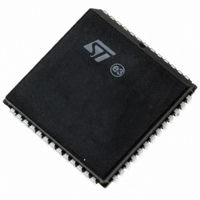DSM2180F3V-15K6 STMicroelectronics, DSM2180F3V-15K6 Datasheet - Page 22

DSM2180F3V-15K6
Manufacturer Part Number
DSM2180F3V-15K6
Description
IC FLASH 1MBIT 150NS 52PLCC
Manufacturer
STMicroelectronics
Specifications of DSM2180F3V-15K6
Format - Memory
FLASH
Memory Type
FLASH
Memory Size
1M (128K x 8)
Speed
150ns
Interface
Parallel
Voltage - Supply
3 V ~ 3.6 V
Operating Temperature
-40°C ~ 85°C
Package / Case
52-PLCC
Operating Supply Voltage (typ)
3.3V
Operating Supply Voltage (min)
2.97V
Operating Supply Voltage (max)
3.63V
Mounting
Surface Mount
Pin Count
52
Lead Free Status / RoHS Status
Lead free / RoHS Compliant
Other names
497-1336-5
Available stocks
Company
Part Number
Manufacturer
Quantity
Price
Company:
Part Number:
DSM2180F3V-15K6
Manufacturer:
FREESCALE
Quantity:
101
Company:
Part Number:
DSM2180F3V-15K6
Manufacturer:
STMicroelectronics
Quantity:
10 000
DSM2180F3V
gram or Erase cycle is in progress or has complet-
ed. Figure 10 shows the Data Polling algorithm.
When the DSP issues a Program instruction se-
quence, the embedded algorithm within the device
begins. The DSP then reads the location of the
byte to be programmed in Flash memory to check
status. The Data Polling Flag (DQ7) bit of this lo-
cation becomes the compliment of bit 7 of the orig-
inal data byte to be programmed. The DSP
continues to poll this location, comparing the Data
Polling Flag (DQ7) bit and monitoring the Error
Flag (DQ5) bit. When the Data Polling Flag (DQ7)
bit matches bit7 of the original data, and the Error
Flag (DQ5) bit remains 0, then the embedded al-
gorithm is complete. If the Error Flag (DQ5) bit is
1, the DSP should test the Data Polling Flag (DQ7)
bit again since the Data Polling Flag (DQ7) bit may
have changed simultaneously with the Error Flag
(DQ5) bit (see Figure 10).
The Error Flag (DQ5) bit is set if either an internal
time-out occurred while the embedded algorithm
attempted to program the byte or if the DSP at-
tempted to program a 1 to a bit that was not erased
(not erased is logic 0).
It is suggested (as with all Flash memories) to read
the location again after the embedded program-
ming algorithm has completed, to compare the
byte that was written to the Flash memory with the
byte that was intended to be written.
When using the Data Polling method during an
Erase cycle, Figure 10 still applies. However, the
Data Polling Flag (DQ7) bit is 0 until the Erase cy-
cle is complete. A 1 on the Error Flag (DQ5) bit in-
dicates a time-out condition on the Erase cycle, a
0 indicates no error. The DSP can read any loca-
tion within the sector being erased to get the Data
Polling Flag (DQ7) bit and the Error Flag (DQ5) bit.
PSDsoft Express generates ANSI C code func-
tions which implement these Data Polling algo-
rithms.
22/63
Figure 10. Data Polling Flowchart
Data Toggle. Checking the Toggle Flag (DQ6) bit
is a method of determining whether a Program or
Erase cycle is in progress or has completed. Fig-
ure 11 shows the Data Toggle algorithm.
When the DSP issues a Program instruction se-
quence, the embedded algorithm within the device
begins. The DSP then reads the location of the
byte to be programmed in Flash memory to check
status. The Toggle Flag (DQ6) bit of this location
toggles each time the DSP reads this location until
the embedded algorithm is complete. The DSP
continues to read this location, checking the Tog-
gle Flag (DQ6) bit and monitoring the Error Flag
(DQ5) bit. When the Toggle Flag (DQ6) bit stops
toggling (two consecutive reads yield the same
value), and the Error Flag (DQ5) bit remains 0,
then the embedded algorithm is complete. If the
Error Flag (DQ5) bit is 1, the DSP should test the
Toggle Flag (DQ6) bit again, since the Toggle Flag
(DQ6) bit may have changed simultaneously with
the Error Flag (DQ5) bit (see Figure 11).
at VALID ADDRESS
NO
READ DQ5 & DQ7
READ DQ7
START
DATA
DATA
FAIL
DQ7
DQ5
DQ7
= 1
=
=
YES
NO
NO
YES
YES
PASS
AI01369B















